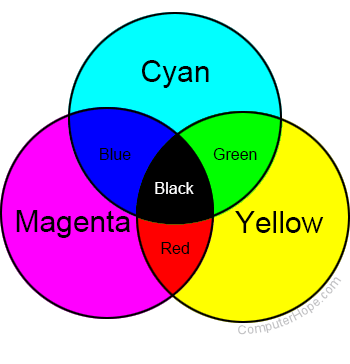Primary color

A primary color is any color that can be mixed with other primary colors to produce all other colors. When learning art in school, you were likely taught that red, yellow, and blue are the three primary colors. However, this is only true in certain situations. With computer displays (e.g., monitors and flat panels) and printers, different colors are considered the primary colors.
Display primary colors
When dealing with a display, the primary colors are RGB (red, green, and blue). Because a screen is black when not illuminated, the pixels that help make a display are additive colors. In other words, to make white, red, green, and blue are all illuminated at the same time. When black is needed, the pixels are not turned on. Different levels red, green, and blue are used for all other colors.
Printing primary colors

When dealing with printing, the primary colors are cyan, magenta, and yellow, which is why most printers have cyan, magenta, yellow, and black ink cartridges or toner (CMYK (cyan, magenta, yellow, and key)). Because most printing is done on white paper, the dots the printer creates subtract the reflective light from it to help generate the colors you see on the paper. If dark or vivid colors are needed, more ink or toner is used. If lighter colors are needed, less ink or toner is used to allow the white paper to give the appearance of a lighter color.
Although all these colors can be combined to make black when black is needed, it's created using a black ink or toner cartridge. Using only one color instead of three helps save how much ink and toner is used.
